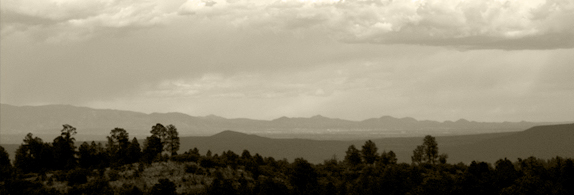The Pollution Industrial Complex

Should anyone doubt the power of money, and money’s service to the so-called national security state, whose agencies spend the nation’s riches like it was jet fuel gushing into an aquifer, one only has to refer to the years of stalling and stonewalling at Sandia National Laboratories (SNL) in Albuquerque regarding the oversight of its nuclear reactors and its mixed waste landfill.
SNL and its sibling at the Los Alamos National Laboratory (LANL) are poster children for the Pollution Industrial Complex in this country and around the world. And New Mexico is the great litter box of high tech droppings, the inevitable pollution that progress, in its twisted relationship to national security, brings.
One can see this clearly in under reported lawsuits brought by Citizen Action New Mexico (CANM) against SNL and the state’s Environment Department last year and this.
It’s important to know, though, that when we use iconic language like Sandia and LANL, we’re talking about corporate and academic America and their relationship to pollution, not necessarily the technical and creative work force of those labs.
SNL is operated and managed by the Sandia Corporation, which is what’s known as “a wholly owned subsidiary of Lockheed Martin Corporation” under a contract with the U.S. Department of Energy’s National Nuclear Security Administration (NNSA). SNL bills itself as the “nation’s premier science and engineering laboratory for national security and technological innovation.” It’s unclear to me, as yet, what the exact remuneration Lockheed Martin receives for running SLN.
Lockheed Martin was formed in l995 with the merger of Lockheed Corporation and Martin Marietta. Last year its revenue was just under $45.5 billion. Its products include munitions, ballistic missiles, fighters, satellites, and spacecraft.
LANL is managed and operated by Los Alamos National Security LLC, a company formed by the University of California and defense contractors Bechtel, Babcock & Wilcox Technical Services, and URS Energy and Construction, under contract to the Department of Energy.
The Pollution Industrial Complex gets what it wants, and gets away with virtually anything, because of a labyrinthine tangle of proprietary secrets, national security secrets, and regulatory relationships with federal and state governments which no mere citizen-voter could ever hope to meaningfully comprehend without the devoted focus of someone living a monk-like existence.
The military and domestic economy of the modern world – in the United States, China, Russia, Europe, Japan, and the industrial giants of the Middle East and Latin America – is based on profit margins by corporate and governmental tangles like these. And those profit margins are often unhappily anchored in pollution, in saving money by fending off requirements to prevent environmental contamination nor to clean it up after it happens. And despite the Clean Air and Clean Water Acts, and all the other environmental laws and regulations, the wealth of these enterprises is still grounded in the heedless creation of public health disasters. It’s so ubiquitous that I hesitate to call it an “unintended consequence” of their activities.
If it weren’t for New Mexico’s deep community of non-profit environmental watchdogs we would know virtually nothing about what’s going on.
SNL has been watchdogged for decades chiefly by CANM, founded by Sue Dayton and now operated by Dave McCoy whom I interviewed on Insight New Mexico several months ago.
CANM isn’t just making things up. In 2002, during the Richardson administration, the state Environment Department determined that SLN’s handling of its toxic wastes was an “imminent and substantial endangerment to health and the environment.” The state concluded that SLN was endangering the water supply. In 2004, after bitter exchanges, Sandia and the Department of Energy signed a “consent order” with the state to take “corrective action” to clean up its waste.
It was right around this time that New Mexico’s powerful senator and ardent nuclear defender Pete Domenici had inserted into the 2003 federal Omnibus Appropriations Bill a provision that forbade the state of New Mexico from forcing Sandia to post bond, or “any other financial responsibility requirement” guaranteeing the clean up of its hazardous waste. In other words, SLN is indemnified by the federal government against all financial claims against it if it fails to clean up its waste. With no bond, only taxpayers are left holding the bag. (Orphaned Land, p. 170)
CANM’s lawsuits, and other court dealings over SNL give us a tiny window onto how it is next to impossible to exercise timely oversight of these immense national security public-private partnerships. Two recent lawsuits deal with long delays in legal requests for information, delays that can only be considered stalling tactics.
In a 2013 suit, CANM charged the National Nuclear Security Agency (NNSA) with a continued “pattern and practice of wrongful delay” of over two years and counting in fulfilling a Freedom of Information Act (FOIA) request for details about the safety conditions of the nuclear reactors at SNL. CANM contended the reactors were unprotected from earthquakes, suffered poor quality of computer software, and lacked procedures to confine plutonium in the case of explosions. The suit cited a 2004 Defense Nuclear Facilities Safety Board report that found “inadequately examined dangers existed at SNL for fire hazards, airplane crashes, and equipment operations.”
Another suit has to do with perhaps the most dangerous nuclear waste situation in the state, the SNL “mixed waste landfill” near Mesa Del Sol’s residential zone overlooking the South Valley. In the l990s it was said of the toxic dump that it was too dangerous to move, but not too dangerous to keep right where it was and, from what I can tell, continue leaching into the groundwater from its unlined pit.
CANM contends that the state Environment Department has let SNL off the hook by ignoring the absolute requirement in the consent agreement for the dump is to be re-examined “every five years” to assess its situation, the health of the ground water, and especially if conditions have changed enough to warrant moving the toxic and radioactive materials from the dump. The suit maintains that the state’s environmental division has tried to weasel out of the exact wording of the five year requirement, contending erroneously that it is ambiguous. How can “every five years” mean anything but “every five years”? The state environment department under the Martinez Administration has extended the five year report deadline to the year 2019. To my knowledge no reassessment of the mixed waste landfill has been officially undertaken since 2004.
The SNL landfill contains some 119 drums of plutonium, tons of depleted uranium, and over “100 radioactive and carcinogenic organics and chlorinated solvents,” according to CANM.
This is why regulating the Pollution Industrial Complex is perhaps beyond even the magical powers of an agency or NGO run by Merlin and Harry Potter. Big Pollution and its federal and state fellow travelers can fiddle and dodge to escape regulations and agreements through the courts for as long as it takes, spinning a web of Kafkaesque complications that simply can’t be parsed out in any intelligible way.
Still, to do nothing is unconscionable. So good for CANM and its small army of volunteers for serving the public’s health and interest by doggedly insisting that slippery corporate and national security polluters follow the rules and the law, even if they find it easy as pie to bob and weave their way out of them.
Fifty Thousand Dollars to Study What??!!

We learned from the fine reporters at KRQE News last week that the City of Albuquerque has signed a $50,000 contract with UNM’s Institute of Social Research to study why police officers don’t employ the on-body video cameras that are required by police policy for them to use. In other words, the City is paying UNM $50 grand to see why some cops are scoff laws when it comes to a following vital evidentiary procedures and the use of high tech equipment, especially in potentially violent situations.
Please tell me this isn’t so! There’s a policy, a particularly crucial one, that isn’t being followed by some officers who are shooters. What does this say to a reasonable person? It says that some police officers are refusing to do what they are required to do. They are giving the finger to authority. And getting away it.
And with a $50,000 price tag it also implies that a great many officers must be ignoring this policy.
You don’t need $50,000, however, to be told what has to be done. Fire the offending officers. Fire their immediate superiors if they don’t start proceedings against them. If one can get away with murdering the drunken, the homeless, or the mentally disturbed, or someone who is a scary nuisance or a belligerent scoff law, surely the city can fire a scoff law cop.
And how should that be accomplished? I’d prefer to see a citizen oversight board that has the authority to call offending officers before it, subpoena witnesses, and pass judgment on an officer’s suitability for continued employment.
We still don’t have a video of the murder of 19-year old Mary Hawkes. The officer who shot her didn’t have the camera on. Or did it malfunction? If it did, how convenient is that? Will we ever know? Will the Mayor order his Chief to cough up evidence in public that settles the question?
If Wisconsin Senator William Proxmire were still alive, he would bestow upon the City of Albuquerque’s $50,000 contract with UNM a Golden Fleece Award for wasting money and fleecing the public.
Video recording devices are almost ubiquitous in America, and cheap. Most of them are simple enough for a five-year old child to use. If the devices that Taser Inc. sells us don’t work, get another supplier. Meanwhile require officers to maintain, clean, and check video equipment, test them every shift, and treat them with the same respect one would show to any other piece of necessary police equipment, such as a gun. Imagine if the Fire Department wasn’t diligent about keeping its equipment in tip top shape and your house burned down because of their incompetence and laziness. These days I sure wouldn’t want a policeman in charge of the upkeep of a fire engine.
If you’re going to militarize the police, militarize discipline too. Don’t coddle and protect people who won’t, or can’t, follow policy. The next shooting in town that isn’t recorded, dismiss the officer, dismiss his superiors, save the expense of their salaries and the inevitable millions of dollars in legal payouts. It’s real simple. And for heaven sakes don’t spend $50,000, or what would amount to a splendid yearly salary for countless people out of work in this city, just to avoid doing what obviously should be done: Impose discipline. Hold employees accountable.
But in our town, the state’s biggest newspaper argues in an editorial that doing a study on why cops won’t follow policy is “$50K well spent.”
How does a Republican newspaper in a fiscally conservative state get away with that? If it wasn’t infuriating, it would be laughable.
What kind of law enforcement agency is so procedurally lax and managerially flaccid that it protects officers who scoff at using vital evidentiary technology as a way to assess culpability in situations of lethal and nonlethal force? But by all means, let’s spend $50,000 to find out why they do it. What?! They do it because they don’t want to get caught.
Why We Love New Mexico – Vastness and Variety

We live in the fifth largest state in the Union geographically. Our 121,589 square miles of land translates into a terrain that’s 342 miles wide and 370 miles long. That’s a lot of wonderful land.
New Mexican territory is so varied in elevation that it has six of the globe’s seven distinct life zones – from desert to alpine.
If you think we’re dry, you’re right. When it comes to surface water we have only some 250 square miles of it, the least of any state at 0.2% of our land mass.
Luckily for many of us, our population is still just barely over two million and starting to decline. So we live in one of the least populated states as well. If having breathing room is a premium, New Mexico’s got it. We’re in sixth place in population density at 17 people per square mile, behind Alaska, at 1.3 people, Wyoming and Montana at 6 and 7 respectively, North Dakota at 10.5 and South Dakota at 11.1. New Mexicans like wide open spaces. Places like Massachusetts with its 858 people per square mile can make us feel slightly nuts.
We are, paradoxically, nearby the far away and, at the same time, far away from everything nearby.
Our biggest cities are isolated from each other in space and time and yet form an archipelago of the modern world in vast oceans of sand and scrub. Los Angeles, Las Vegas, Denver, Salt Lake City, Phoenix, Tucson, and the big cities of Texas are comfortably far away and relatively easy to get to.
For Westerners who aren’t fond of crowds and yet need urban amenities and wild open lands, we have it all. Our physical size, our low population, the cultural richness and diversity of our people, are mirrored in our landscapes and how we’ve adapted to them.
While most towns are isolated in New Mexico, they all fall within something, mas o menos, of a 200 mile radius from Albuquerque. That includes, Raton, Roswell, Alamogordo, Las Cruces, Silver City, and Gallop, Las Vegas, Santa Fe, Los Alamos, Farmington, Zuni, Acoma, and parts of the Navajo reservation. They are nearby, but culturally and geologically far away.
To get virtually anywhere in our state, one is graced by great psychological distances of open land. Just driving the hour it takes to get to Santa Fe from Albuquerque you pass through areas of mountain building and volcanism, arroyo making, and high desert scrub lands, past the Jemez Mountains, the Sandias, the San Pedros, the Ortiz, the Cerrillos Hills, the La Bajada escarpment and into the southern end of the Rockies, with the Sangre de Cristos, Truchas Peak and the Pecos. If you go a little farther east you find yourself where the Rockies stop and the Great Plains begin just on the outskirts of the city of Las Vegas.
The vast distances in our state and our vast differences -- all nearby in the sense of being readily accessible with an adventurous spirit by car, and some by train or bus -- gives New Mexico its sense of freedom, its feelings of refuge and oasis, its sensation of being a promised land where people can make of their lives what they will.
We are a place where individuals and whole cultures can struggle successfully to maintain their integrity in the face of the rapacious conformity of global consumer culture, and where the creative independent spirit can flourish in what might be called a spacious community of solitude in a land big enough and varied enough to accommodate the riches of our eccentricities and refinements of our intellects.
Size, distance, emptiness, variety, community and intimacy all come together in New Mexico to turn a harsh and strenuous environment into a homeplace for those of us rooted here by history and temperament who would never dream of living anywhere else.
(The distances recorded here are as the crow flies.)
(Photos: Radiation warning by Nicolas Raymond; Police body camera by West Midlands Police; New Mexico vista by Joe Lewis)




Responses to “Provincial Matters, 9-8-2014”